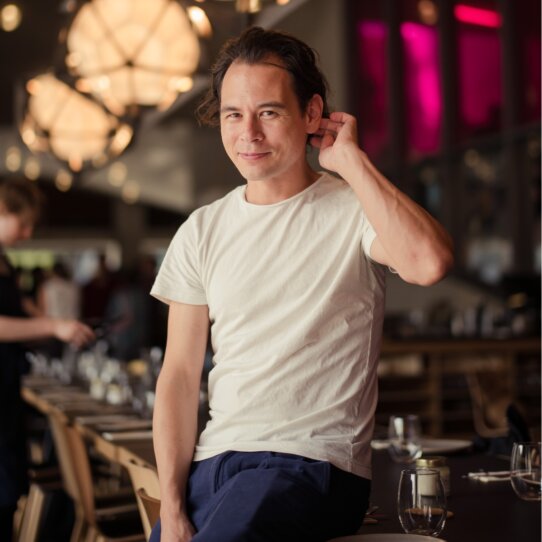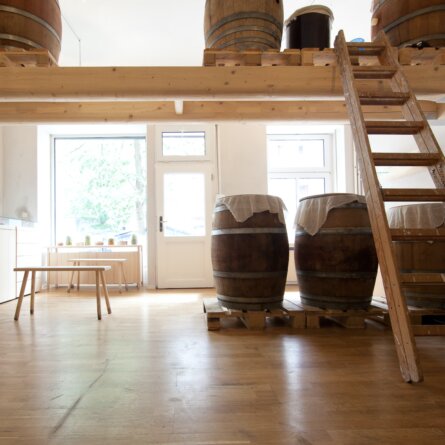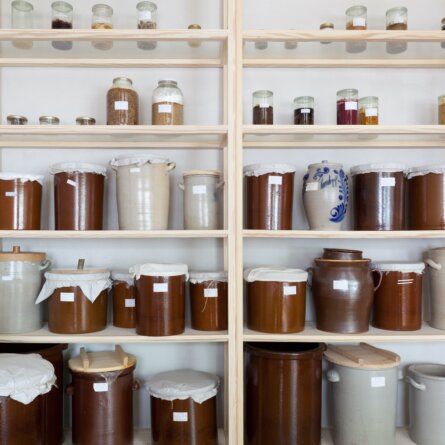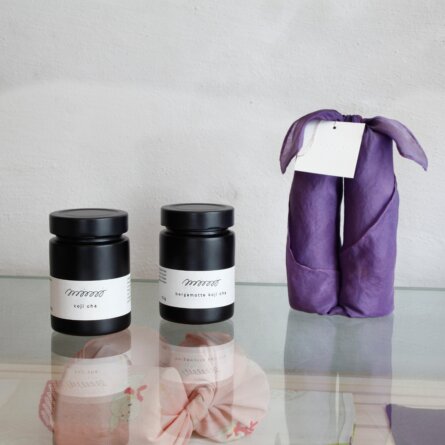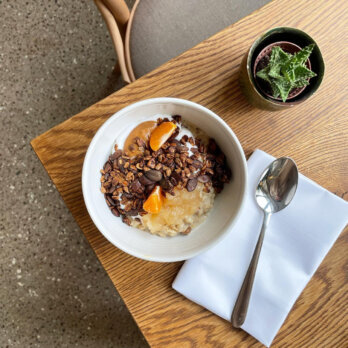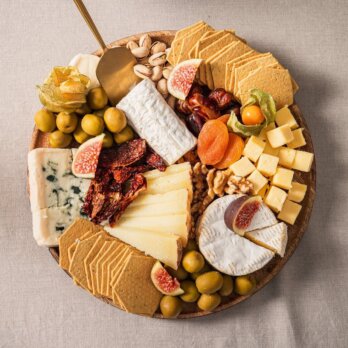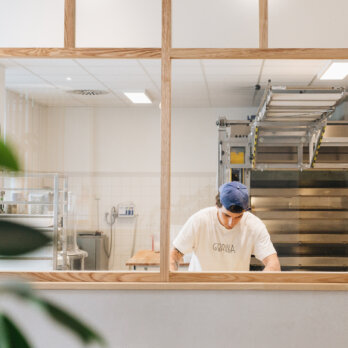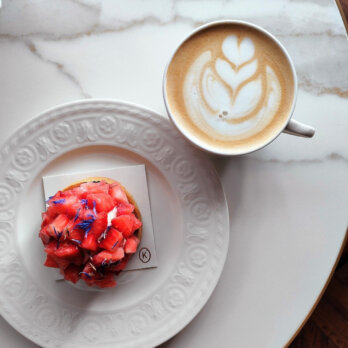Monday to Friday: 10:00am - 6:00pm
I can't even say what I expected, and yet it looks so different from what I imagined. What first catches your eye are probably the wooden barrels, on wooden beams above the room and on the floor. On shelves further back in the room, different vessels are made of glass and ceramics. At Mimi Ferments, it looks less like a pharmacy or laboratory, more like a vintner or bakery perhaps.
After all, fermenting is also an ancient craft. The microorganisms, yeasts, and bacteria, which help to not only spice up the taste of food, but also make it more digestible and even healthier, have been with us as long as we have existed. Sauerkraut, yogurt, bread and wine, but also miso and soy sauce, are all ferments that expand our culinary and nutritional palette.
The original technique exists all over the world. In Berlin, Markus Shimizu contributes to its popularity like hardly anyone else in Germany. The creative mind behind Mimi Ferments greets me in a reservedly friendly manner in his shop in Moabit. Markus studied art. He has traveled a lot in his life, he says, and has always found it exciting to try local cuisine. "I'm quite experimental," he says about himself.
Thanks to his Japanese father and because Markus lived in Japan until he was eight, he was familiar with fermentation, which is highly valued there, from an early age. Japanese cuisine has left its culinary mark on him. Since his mother is German, he also knows German cuisine well. For Markus, nutrition is not just about filling his stomach but in a way also medicine. That is why he has lived vegan for a long time, mainly for health reasons.
In the 90s, however, there were not yet many options for vegan food, so in early 2000 he began looking into fermentation. In Holland, he got to know tempeh, a vegan soy ferment that contains many high-quality proteins. Markus experimented with it, made his own tempeh and natto.
Today, his favorite product is Shiro Miso - young rice miso: "It's relatively mild, fruity, a bit cheesy, has a bit of a Parmesan flavor. It's quite pleasant, and you can almost even spoon it. It's nice on pasta with olive oil, for example, maybe a little garlic still or pepper."
THE FERMENTER THAT TOP CHEFS TRUST
Markus has lived in Berlin since 2000. Back then, there was still a lot of freedom here, many things were possible, and many international people came to the city. When he started Mimi Ferments in 2017, the restaurant scene in Berlin was in a state of upheaval. "A lot of new restaurant concepts were just emerging, and I was able to participate in that a little bit. That was nice," Markus recaps. He is making a name for himself, not only but especially among Berlin's Michelin-starred restaurants.
"The most famous customer is perhaps Tim Raue," Markus guesses, and you can see the pride in him a little bit. In addition, Mimi Ferments supplies customers and Michelin chefs all over Germany, Italy, Holland, Belgium. "I think they just appreciate the quality. It's just a much better product than what you normally get." Of course, you can now also get a small selection of premium products from Japan through delicatessen stores. Still, at Mimi Ferments, everything is always available, and you have a personal connection to it. You can exchange ideas.
Another advantage is that Markus and his staff also do many "special things" for certain restaurateurs. "They come up with their own ideas or have too much of something. For example, Rutz once had too much chicken because they only used the breast and not the rest. They couldn't eat it all in their staff meal. Then we just made a barrel of chicken garum."
So, in addition to artisanal miso or soy sauce, Mimi Ferments also produces extraordinary and particular things that are not available anywhere else and are entirely unique. Fermentation is actually very creative, at least the product development is. Although you can tell Markus is an artist, art hardly occupies a place in his life these days; Mimi Ferments is a full-time job.
AROUND 70 BARRELS OF SOY SAUCE MATURE AT MIMI FERMENTS
But Markus doesn't do the fermentation himself anymore. "I do everything that other people don't do," he laughs softly. Planning, workshops, and interviews, for example. Because he is a true luminary in his field - including a cover story in Zeit magazine. You can book his fermentation workshops online, but he also does some on request, for kitchen staff, for example. These are usually tailored to individual wishes. For instance, he taught the Standard Pizza team some techniques and showed them what was possible.
His four employees take care of the ferments in addition to the shop. They are all career changers. "There is no miso-making profession as an apprenticeship," Markus says. "That's why they are basically people who are interested in it and have already done a bit of fermentation. We also have Japanese employees who know it from home."
They look after around 70 barrels. Soy sauce, for example, matures in them. Some things have evolved for quite a long time, the oldest shoyu, for example, for 3.5 years. It is still regularly fed and almost looks like a juicy chocolate biscuit. As a rule, pre-aged barrels are used for the ferments: Red wine barrels, whiskey barrels, bourbon barrels, rum barrels. Depending on the ferment, Markus chooses what fits.
The flavor of the pre-aged barrels is also released during the first few uses, after which you can taste the wood above all. This is because the wooden barrels are a good size and do not interact with the salt or acidity of the ferments.
WHEN BARLEY BECOMES APPLE JUICE
But what fascinates Markus most about his work? He laughs softly. "On the one hand, that you can get to know very many new facets of the raw materials." You might think you know wheat, barley, or maize, but through fermentation, you learn about entirely new facets of the commodities once again, he says. "For example, a barley koji can smell like apple juice, or sweet potato miso can taste like Capri-Sun. You wouldn't expect a sweet potato to taste like an orange," Markus explains.
You can also get very thorough with fermentation, he finds. "It's like a plant or a living thing with which you can build a relationship." Ferments like miso, shoyu, or natto are dynamic, he says, requiring particular dedication. "It's not something mechanical, it's something living that you can endlessly feel into and get feedback from." That's why Markus also finds some principles in fermentation that can be applied to society and how we treat other individuals.
THE CONNECTION BETWEEN FERMENTS AND PEOPLE
I get puzzled: for example? "With ferments, it's like this: you have to set framework conditions so that the ferment can mature successfully and come into being at all. If these framework conditions are not good, then it goes wrong, and it's the same with people." That makes sense.
At the same time, one also learns that all organisms have an optimum somewhere. A ferment thrives best at this temperature, humidity, pH value, but it doesn't necessarily need it. "And people also have their optima, but obstacles can be overcome. So it is precisely these things, for example, temperature fluctuations, that are perhaps not always in the ideal range. If you do everything at the optimum, some things go very quickly. But that doesn't mean it's also the best taste. Then, for example, complexity is missing. This also applies to people: it is precisely obstacles that help you grow and perhaps become a better person," Markus continues.
FERMENTATION STABILISES ITSELF
Until today, many people do not dare to ferment, although it is not that difficult: you only have to set the framework conditions, work reasonably clean, and then it works. Then there are those, who need a bit of care. For example, soy sauces have to be stirred. Some others, like miso, can simply be prepared and opened when they are ripe.
"Fermentation is a process that stabilizes itself," Markus explains, "which means that at the beginning, the products may be vulnerable or unprotected, but through fermentation, a microbial flora builds up that protects the ferment, and thus it becomes more and more stable and problem-free." Markus suspects that people's reluctance to do their own fermentation, more likely exists since they don't know it (anymore) or have little experience with it.
A RETURN TO ONE'S SENSES
In principle, however, humans and the body have a lot of experience with food. We have formed sensors for all the toxins relevant to us and can taste them. You can taste mold, for example. You notice when something is no longer good when it smells funny. So we should simply trust our taste sensory system, Markus thinks.
That's also the nice thing about fermenting, he says, that you regain this trust in your senses. "I can say that I don't have to have it tested by the lab and it doesn't all have to be packaged goods. Just like when you bite into an apple: the apple has been hanging on the tree for maybe half a year, maybe a blackbird pooped on it or something, and I don't know. But you survive that; we are equipped for it. So maybe we have to regain that a little bit, that self-image." After all, people have been fermenting for thousands of years - it's an ancient craft - it's a nice thing that Mimi Ferments is helping to make it popular again.
